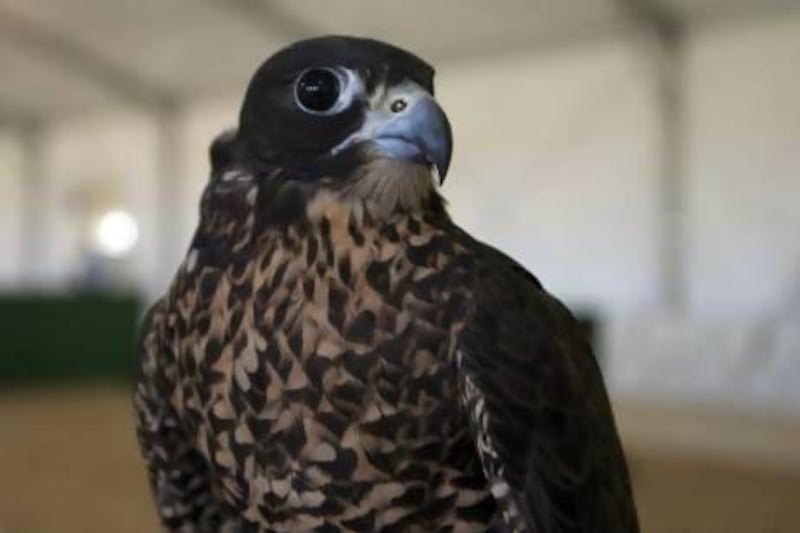How do you tell the difference between a peregrine falcon and a chicken?
It sounds like the opening of a bird-brained joke. But the objective of a unique new scientific analysis of the genome of one of the deadliest birds of prey, comparing it for reference to the known genomes of chickens, turkeys and the zebra finch, is no laughing matter.
The year-long study, says Professor Michael Bruford, a molecular ecologist at Cardiff University's School of Biosciences, has been all about supporting falconry's Unesco status as an Intangible Cultural Heritage, ensuring that wild populations of rare falcons are protected and gaining insights into the evolution of a predatory lifestyle.
"This is supportive science," says Prof Bruford, co-author of a paper on peregrine falcon genome sequences published last month in the journal Nature Genetics.
"The idea is to develop ways to take the pressure off wild populations of falcons by providing breeders with tools which mean they can do their selection in captivity as opposed to going out and taking birds in the wild."
Captive breeding programmes, he says, are essential to prevent illegal trapping.
"For example, one of the most popular birds for falconry enthusiasts in the Arabian Peninsula is the big white gyr falcon, but not every one bred in captivity is white - captive breeding throws up a lot of grey and black ones.
"Last year, we discovered a mutation in the gyr falcon that codes for having white plumage. Now, if we can select individuals in captivity based on the presence or absence of that particular mutation, then falconers won't be sending their trappers up to Greenland to catch big white falcons from the wild."
It took two years from collecting the first blood sample to publishing the groundbreaking new paper, which reports on the first sequencing of the entire genomes of the peregrine and saker falcons - the first birds of prey, in fact, to be analysed.
The sequencing work was carried out in China at BGI-Shenzhen, a non-profit research institution, says Prof Bruford, "because they have the world's best genome sequencing factory, which can do it very quickly, and they also have very large computers which allows us to piece together the bits of DNA into the whole genome very efficiently".
Yet sequencing a genome produces so much data that even with the best computers in the world working on the problem full time it still took about a year to carry out the analysis.
The result, as even Prof Bruford admits, is not in any sense an easy read.
The paper is "incredibly technical stuff, and there is an absolutely extraordinary amount of data", he says.
"We are describing 240 billion base pairs of DNA sequence that we produced for this one paper. If you consider that you and I have three billion base pairs and that it took the scientific community 10 years to sequence the human genome, it's not surprising that people find it a bit technical."
Yet, tough read or not, the paper is a vitally important milestone in a number of ways.
Since the first bacterium was sequenced in 1995, the genomes of only 180 organisms have been divined - and the majority have been bacteria.
So far, including homo sapiens, the genomes of only 27 mammals have been sequenced, ranging from the dog, cat and horse to the chimpanzee, giant panda and bottlenose dolphin.
Until now, however, only five birds in the world had been been sequenced: two types of flycatcher, the chicken, the zebra finch and the turkey.
This is the first time the genome of any bird of prey has been sequenced - and the paper compared the genomes of the peregrine and the saker with those of the chicken, zebra finch and turkey to map the progress of diversification along the evolutionary tree.
It was, says, Bruford, the only way to begin understanding the subtle differences between falcons - differences that can help breeders to produce what falconers are looking for, without disrupting populations in the wild, and differences which plain DNA profiling cannot detect.
"DNA profiling tells you about your ancestry but it doesn't tell you about ongoing selection and evolution in your genome. So if you want to tell the difference between a pale saker from the steppes of Russia and compare it with a dark bird found on the Qinghai-Tibetan plateau, you might not find any difference in their DNA profile.
"But if what you and the Arabs are interested in is why does this one fly faster, why is this a gamer hunter, why does this take this kind of prey, why is it coloured in this way, the only way to find out is by scanning the whole genome and looking for genes that are behaving in a way that's different to the DNA profiles."
And what scientists collaborating in Abu Dhabi, Denmark, China, Saudi Arabia and Wales found was "genome-wide evidence for evolutionary innovation and selection for a predatory lifestyle".
In short, while birds such as the chicken could scratch a living in the dirt, but lost the ability to fly in the process and found themselves shunted down the food chain, the falcon, faced with the need to hunt or die in often harsh terrain, developed sharp eyesight, killer beaks and talons, and the ability to drop on their prey from a great height.
And at a terrific speed. Only extremely specific physiological evolution allows the peregrine falcon to be the world's fastest creature.
"A peregrine falcon can swoop at 380kph," says Prof Bruford. "If they didn't have physiological adaptations their lungs would be destroyed by that kind of G force and stress, but they have bones in their nasal cavities that deflect the air away so they can survive it."
The study also found that evolutionary change among falcons has taken place rapidly - and relatively recently.
"The peregrine and saker species diverged about 2 million years ago," says Prof Bruford, "but the rate of evolution among their genomes is much higher than in the other birds we've looked at so far."
Such divergence, or "speciation", can occur for many reasons, but rarely does it occur as rapidly as it has among some branches of the falcon family. In fact, says Prof Bruford, the saker "is part of a group that is still speciating at the moment - the saker, the gyr and the lanner falcons, which are all famous falconry birds, really only diverged a few tens of thousands of years ago".
The key to that, believe the scientists, was environmental pressure on the birds to widen their ecological niche.
"The gyr falcon is a predominantly pale falcon that lives up in the Arctic, the saker is a steppe and desert bird, and the lanner tends to be more tropical in its distribution, but they all come from a recent common ancestor, and they've separated because of their habitat and they've done it very quickly."
This poses an as-yet unsolved question: how will these birds cope with rapid climate change caused by mankind?
Human beings had nothing to do with the original speciation, "but the effect of the way man is changing habitats now is going to be profound", says Prof Bruford.
"The genomes of these animals have shown some really rapid evolution; they are now top predators, very highly adapted to their system.
"The question is, if the climate changes very quickly, will they be able to adapt quickly again, or does it mean they are so highly adapted to their ecosystem now that they won't stand a chance if it changes any more?"
There is more work to be done to provide an answer. "Until we start sequencing individuals from across the whole range, we won't know which of these two scenarios is most likely."
For now, though, these birds that have carved out such unique niches for themselves are, fittingly, benefiting from scientific protection originating among the Arab peoples who were among the first to identify and exploit their capabilities.
The expensive and time-consuming genome sequencing that underpins the paper, carried out in a specialist laboratory in China, was funded by the Environment Agency Abu Dhabi, and the DNA samples were taken from two wild birds being cared for at Abu Dhabi Falcon Hospital, whose director and senior veterinarian, Margit G Muller, was a co-author of the paper.
Abu Dhabi has long taken a leading role in the conservation of falcons. Falconry's Unesco status was achieved in 2003 thanks to representation by Abu Dhabi and, for the past 19 years, the Sheikh Zayed Falcon Release Programme run by the Environment Agency Abu Dhabi has returned more than 1,360 falcons to the wild.
Fascinatingly, says Prof Bruford, the process represents a return to older ways.
One of the most sought after sub-species for Arabic falconry is the calidus falcon, which breeds on the Arctic Circle on the northern coast of Russia.
"It does these enormous 3 or 4,000-kilometre migrations in the winter," Prof Bruford says.
"Traditionally, the Arab falconers would trap the birds on their southerly migration then they would train them up, hunt bustards with them over the winter and then let them go again, to complete their northward migration back to their breeding grounds.
"That was an entirely sustainable approach, but of course what has happened is that those traditional Bedouin practices are a lot less prevalent these days and there has been illegal trapping and the pressures on populations have changed."






